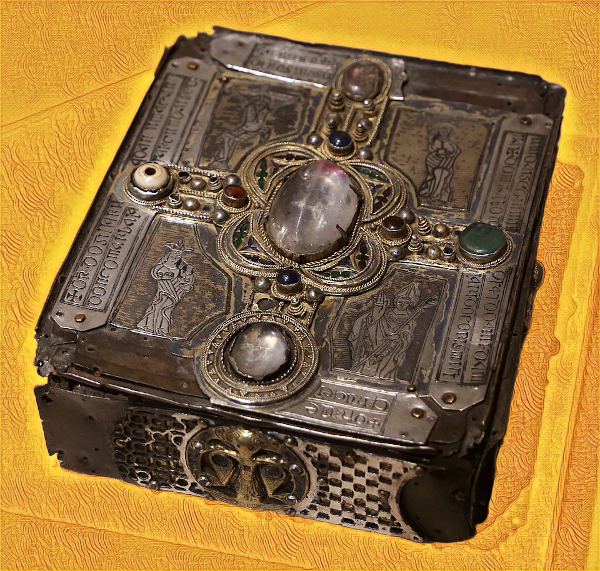News, See Page XX
See P. XX: What’s in that Cumdach?
A column about roleplaying
By Robin D. Laws

After a four decade restoration project, a book shrine found in a lake has gone on display at the National Museum of Ireland. Only seven others of its kind survive. Known as cumdachs, these elaborately decorated cases of metal-shod wood were fashioned to contain precious devotional manuscripts. Most were made centuries after the books they housed. Before the centuries took their toll, these would have been objects of considerable heft. This cumdach’s longtime carer, conservator Paul Mullarkey, describes the newly displayed Lough Kinale Book Shrine as being about the size of a telephone directory, for those of us who remember how big those used to be.
In your 13th Age or Swords of the Serpentine games, book shrines might show up simply as items of value for freebooting adventurers to locate, capture, and sell. If they’re of devotional significance they might be hired to acquire one for a 13th Age icon, like the Priestess, or for one of Eversink’s more savory cults. When the case has succumbed to age, allowing the text inside to molder, the jewels adorning it still fetch a high price on their own. In a fantasy game the tome inside might contain spells the magic-wielding adventurers can add to their character sheets, or employ as a one-time weapon against an otherwise unbeatable threat. The book could contain maps of Dragon Empire dungeons or details of their construction the heroes can use to efficiently plunder them.
A key fact about real world cumdachs may horrify the bibliophile: the cases were meant to seal up the books inside forever. This converted them from texts for use into sacred relics, often of the saints who in truth or legend once owned them.
When horror GMs hear of cases meant to seal away books for all eternity, especially an example found centuries later by metal detectorists after someone tossed it into a shallow, swampy lake, they nod knowingly. What if the case is not meant to glorify the former owner of holy book within, but to act as a containment unit for a dangerous tome of eldritch lore?
We would never say, of course, that the volume inside the Lough Kinale cumdach is a Gaelic version of the Necronomicon. But in your game it might be. Exactly when it was heaved into Lough Kinale can’t be pinned down. Maybe that happened later than we assume, in the 1930s, say, by a team of occult investigators who had researched Kinale’s protective ley resonance and didn’t expect pesky metal detector hobbyists to dredge it up a mere half century later.
Speaking of books that need to be placed in protective casing and thrown into bodies of water, the notorious play The King In Yellow also comes to mind. Could a cumbach protect the world from an early Irish elegy bemoaning the entrance into the world of a masked king and his daughters? A jaunt from 1895 Paris to Ireland might send the art students of Yellow King: Paris in search of the play’s original source, perhaps leading to its actual author. They might discover that the Old Irish version has an even greater corrosive effect on reality than the recent Decadent adaptation, giving them a second book they must now suppress. Maybe they’re the ones who heave it in a lake.
When they do use the common lake disposal method for insidious elegies, their later counterparts might encounter it again. If they took it back with them to France, the soldiers of The Wars might find it causing trouble when its Carcosan energies leach into a spring a regiment has been using for drinking water.
Aftermath’s ex-insurgents might discover that a cumdach containing the play was given as a gift to one of the Castaigne Emperors. Learning that it went astray in the looting of the imperial collections, they race to recover it before a revanchist cell finds it and uses it to refresh their waning parageometrical powers. In This is Normal Now the everyday investigators might find themselves mopping up reality shifts when metal dectectorists find a cumdach with a jeweled Yellow Sign on its early medieval casing.
A Fear Itself scenario casts the player characters as discoverers of the encased and carefully discarded book. By dredging it up they attract unremitting horrors, who may or may not come at them when they pry it open in an old cabin in the forest.
In other GUMSHOE horror settings the investigators could repurpose the casing of a cumdach to neutralize a sinister volume. In its arrogant 60s heyday the covert cowboys of DELTA GREEN might not flinch at an incursion into an ill-secured Irish museum to filch a real casing and replace it with a duplicate. In this version the book shrine might serve as a McGuffin to lure the agents toward something else in the collection they don’t want to mess with.
Night’s Black Agents operatives might not need the literal casing to use it as a containment unit. When they discover a book of telluric blood magic or the mathematical equation that turns stalwart opsec experts into Renfields, they might need to steal only the 3D rendering of the cumbach made by museum conservators. No, not the one used for the public display, the unredacted one, which they can use to fashion a containment cumbach themselves. Certainly the conspyramid has not thought of this, and hasn’t created a sort of virtual cumbach in the schematics, to Renfieldize them.
Swap in Ordo Veritatis investigators for burned spies and Outer Dark Entities for vampires, and you’ve got a version for The Esoterrorists. Alternatively, an Esoterror cell might take advantage of a new metal detecting find of a ninth cumbach. Its members spread rumors of yet more treasures to be found in the lake, forest or swamp where it was found. They then seed the location with a forged casing housing a fake occult tome that becomes increasingly real when the tabloids get ahold of the story and whip up a sensationalistic panic around it.

